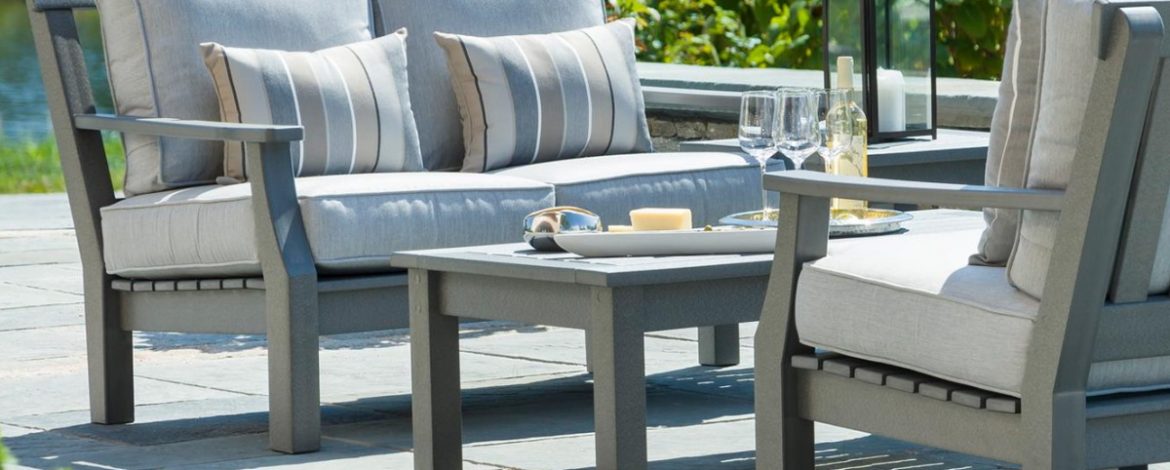Garden Furniture
Garden Furniture |
|
|
Materials for Outdoor Furniture Frames and Tabletops |
|
|
|
|
| Wood Wood has been a popular raw material for furniture for millennia. It has a natural beauty, is generally easy to work with and provides a sturdy framework for tables, chairs, benches and other furnishings. However, not all woods are created equal when it comes to outdoor usage. typically more expensive than softwoods. But, there are major differences between hardwoods too. |
 |
 |
Teak Teak is easily the most popular wood choice for outdoor furniture. Its high demand, coupled with limited availability, has pushed the price of this fine-grained hardwood extremely high. Fortunately, teak has many characteristics that make it ideally suited for outdoor use. It is incredibly strong and doesn’t warp, crack or become brittle like many kinds of wood.• PROS – Durable, strong, resistant to weather, decay and insects, no cracking or warping and it’s easy to care for • CONS – High price |
| Eucalyptus This strong Australian hardwood is fast-growing, lasts a long time and offers significant cost savings versus teak. Its natural washed appearance has a rustic appeal, which will develop into a silver patina unless oiled regularly. It is weather and rot resistant and its oil acts as a natural insecticide.• PROS – Durable, insect and rot-resistant, eco-friendly sustainable growth and cost-effective • CONS – Susceptible to marine and pinhole borers and vulnerable to cracking if untreated with a sealant |
 |
 |
Ipe Central and South American ipe (a.k.a. ironwood), unlike many of its hardwood counterparts, has a deep rich colored grain which fades slower when exposed to weathering [Jankowska,• PROS – Durable, strong and resistant to pests and fungi • CONS – Difficult to work with |
| White Oak This abundant wood is stronger and harder than most and lasts for decades. It has long been used to build boats, due to its structural ability to repel water, which also helps it resist rot.• PROS – Water-proof, rot-resistant and strong • CONS – Low oil content |
 |
 |
Metal Metal is typically the strongest and most durable material for outdoor garden furniture. Because of its strength, metallic frames can be thinner and shaped into more complex designs than other options, giving manufacturers greater style flexibility. Metal is also a great choice when used in combination with other materials that have their own functional and aesthetic benefits. |
| Stainless Steel This sturdy metal alloy is extremely strong, which makes it a great material option for large weight-bearing outdoor dining tables, sofas and sectionals. Its high density helps prevent dents and other damage from frequent use. While it does get hot to the touch when exposed to the summer heat, stainless steel endures extreme temperatures better than most metals.
Garden Furniture |
 |
 |
Aluminum Aluminum is the most popular metal for outdoor furniture. Despite its lightweight, it is strong, durable and can easily be worked into a variety of intricate shapes. Aluminum is relatively inexpensive, low maintenance and never rusts. Although it is highly weather-resistant on its own, a polyester powder coating is recommended.• PROS – Strong, lightweight, weather-resistant, inexpensive and low maintenance • CONS – Hollow tube frames may blow over in high winds and it retains heat |
| Wrought Iron Throughout history, iron has been used for tools, buildings and furnishings because of its strength and durability – it can last a hundred years if properly cared for. It’s among the heaviest of metals, which makes it difficult to move wrought or cast iron furniture. However, it certainly won’t blow over in the wind.• PROS – Durable, solid, stylish classic look and great for windy areas • CONS – Rusts easily, requires more maintenance, can be uncomfortable, difficult to move and retains heat or cold.Garden Furniture |
 |
 |
Resin & Plastic Man-made synthetic materials, such as resin and plastic, are becoming more and more prevalent in the world of outdoor furniture. New manufacturing processes and hybrid compositions enable these polymers to take on shapes and sizes previously unattainable. Synthetics are typically lightweight, inexpensive and can be molded into any decor style imaginable. |
Materials for Outdoor Furniture Upholstery, Slings and Pillows |
|
| Fabrics Outdoor furniture cushions, slings and accent pillows require fabrics that can withstand the stringent demands of constant exposure to the elements. Natural fibers tend to lose vibrancy and break down over time. Consequently, fabrics made from synthetic thread, infused with plastic, are much better options for outdoor upholstery covers. |
 |
 |
Acrylic Fabric
Outdoor fabrics made from acrylic fibers are strong and resistant to both weather and use damage. It’s mold and mildew resistant and can hold up against rubbing and tearing. Olefin Fabric |
| Polyester Fabric This synthetic material is typically coated with either an acrylic or vinyl (PVC mesh) to protect it from the elements. Polyester is strong, flexible and resists water damage and staining. It’s tear-resistant and dries quickly, but most outdoor polyester fabrics (at least the non-treated average grade options) fade faster than other synthetic textiles.• PROS – Strong, resists tearing and water damage, quick drying and comes in bold colors and patterns • CONS – Tends to fade fast than other fabrics |
 |
| Thanks To: DECOR INTERIORS | |


